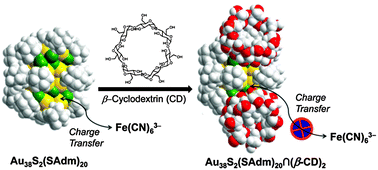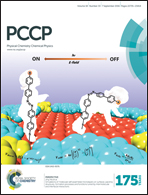Surface modification of adamantane-terminated gold nanoclusters using cyclodextrins†
Abstract
The surface functionality of Au38S2(SAdm)20 nanoclusters (−SAdm = adamantanethiolate) in the presence of α-, β-, and γ-cyclodextrins (CDs) is studied. The supramolecular chemistry and host–guest interactions of CDs and the protecting ligands of nanoclusters are investigated using UV-vis and NMR spectroscopies, MALDI mass spectrometry, and molecular dynamics simulations. In contrast to α- and γ-CDs, the results show that β-CDs are capable of efficiently chemisorbing onto the Au38S2(SAdm)20 nanoclusters to yield Au38S2(SAdm)20–(β-CD)2 conjugates. MD simulations revealed that two –SAdm ligands of the nanoparticle with the least steric hindrance are capable to selectively be accommodated into hydrophobic cavity of β-CDs, as furthermore confirmed by NMR spectroscopy. The conjugates largely improve the stability of the nanoclusters in the presence of strong oxidants (e.g., TBHP). Further, the electrochemical properties of Au38S2(SAdm)20 nanoclusters and Au38S2(SAdm)20–(β-CD)2 conjugates are compared. The charge transfer to the redox probe molecules (e.g., K3Fe(CN)6) in solution was monitored by cyclic voltammetry. It is found that β-CDs act as an umbrella to cover the fragile metal cores of the nanoclusters, thereby blocking direct interaction with destabilizing agents and hence quenching the charge transfer process.


 Please wait while we load your content...
Please wait while we load your content...